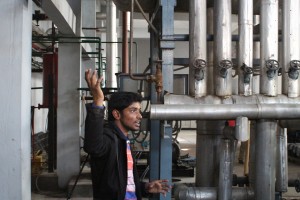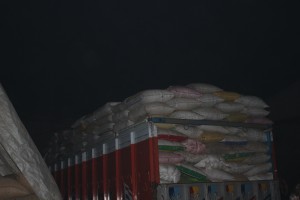By Kathryn Johnson, University of Illinois junior majoring in food science and human nutrition
This series of posts was written by students in the ACES 298: Postharvest Loss Prevention study abroad program, which introduces participants to postharvest processes of grains and perishables and loss prevention in the Bihar and Punjab areas of India.

RAU student Vivek Dubey explains part of the potato cold storage facility near Pusa. Photo credit: ADMI/Alex Lake
Today was a busy and important day; we had the chance to meet our students counterparts from RAU, listen to lectures, and go on field visits to three different locations. My student partner’s name was Rabina Gupta – a third-year student studying agriculture. After meeting the students we were partnered with at RAU, we had the opportunity to talk with them and get to know them better before a lecture by Professor Kathy Baylis. Baylis discussed the economic importance of postharvest loss (PHL) prevention and gave some possible solutions. What I found interesting were the agricultural policies and their impact in PHL. I am excited that this project is being addressed from various angles, ensuring its success in the future. Next was the inaugural session, when everyone that helped or was involved with the project was thanked and the intentions of this trip were explicitly stated.
An RAU faculty member was next to speak. She discussed postharvest processing of grains and cereals, the losses that occur, and some other issues. As a food scientist, I vaguely recognized this process, so this lecture was a great lesson of how cereal and grain processing takes places. It was also helpful because my RAU partner is very knowledgeable in this subject so during this lecture she was able to further explain the process taking place.

A truck ready to transport grain from the rice milling facility to an FCI godown. Photo credit: ADMI/Alex Lake
After lunch, we began our field visits. First, we went to a potato storage unit where the structure was concrete with bamboo floors. The entire building is cooled using liquid nitrogen that is recycled, which helps minimize waste. Next, we headed to the RAU campus where the information that the RAU faculty member lectured on was very applicable. We saw how the university does seed and grain processing, and later we visited a privately-owned rice company. The plant at the university was very clean regarding the processing and packaging compared to the privately-owned plant. There were many techniques, such as the removal of the husks and sorting foreign materials, in which the private plant and the university utilized the same techniques. The private corporation seemed a bit more advanced than the university because it had a rice sorter that used spectroscopy to pick the white rice grains from the diseased grains.
Overall, this first day of lectures, RAU student interaction, and field visits seemed very successful and has made me excited to learn more during the rest of our visit.
Kathryn is a participant in the ACES 298: Postharvest Loss Prevention class organized by the ADM Institute for the Prevention of Postharvest Loss at the University of Illinois at Urbana-Champaign. Throughout the 12-day trip, students interact with policy makers and business partners in the agriculture industry, and work with fellow students at Rajendra Agricultural University (RAU).
Read more blogs in this series:
Travelogue 1: Greetings from India
Travelogue 2: Fascinated by Indian culture, architecture
Travelogue 3: Leaving the city behind
Travelogue 5: To the villages of Bihar, we went
Travelogue 6: Stress in numbers for India rice losses
Travelogue 7: These issues impact all of humanity, we need to learn to work together
Travelogue 8: Like Buddha, seeking enlightenment through partnership
Travelogue 9: Drones, sub-surface irrigation, and other ‘game-changing’ technologies at BISA
Travelogue 10: A fond farewell to India


No comments yet.